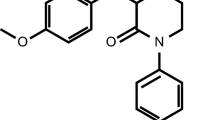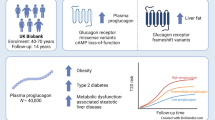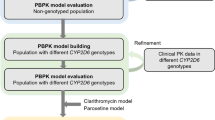Abstract
Warfarin anticoagulation is complicated by the highly variable inter-individual response. Approximately 50% of the dose variability arises from clinical factors and variants in two genes, CYP2C9 (*2 and *3 variants) and VKORC1 -1173 C > T. We tested variants in five additional genes (EPHX1, PROC, APOE, CYP4F2, CALU and a new variant in VKORC1 in an attempt to further reduce the variability in predicted stable warfarin dose. Consecutive consenting outpatients requiring anticoagulation on stable warfarin dose (target INR 2–3) were genotyped; the association of SNP genotypes with stable warfarin dose was evaluated using the test of linear contrasts in analysis of variance (ANOVA). Study participants were 71 ± 13 years, 53% female, 85 ± 23 kg, body mass index 29 ± 7 kg/m2. Genotypes were in Hardy–Weinberg equilibrium with the exception of VKORC1 -1639. Weekly stable dosages were 31.7 ± 13.9 mg/week; median: 30 mg/week, range: 11–70 mg/week. Significant associations with dose were seen for VKORC1 -1639 (P < 0.001), CYP2C9*2 (P = 0.005) and *3 (P = 0.003), the CYP4F2 SNP (P-trend = 0.00037), and VKORC1 3730 (p-trend = 0.042). In linear regression, age, sex, weight, and CYP2C9 *2 and *3 and VKORC1-1639 genotype explained 42% of variance. The addition of CYP4F2 genotype to the regression model increased the degree of variance explained to 47%. Addition of VKORC1 SNP -1639 to a model eliminated the association of VKORC1 3730 with warfarin dose (P-trend = 0.74), but -1639 remained highly significant. No impact on dose was observed for the other tested genetic variants.
Similar content being viewed by others
References
Sconce EA, Khan TI, Wynne HA, Avery P, Monkhouse L, King BP, Wood P, Kesteven P, Daly AK, Kamali F (2005) The impact of CYP2C9 and VKORC1 genetic polymorphism and patient characteristics upon warfarin dose requirements: proposal for a new dosing regimen. Blood 106(7):2329–2333
Vecsler M, Loebstein R, Almog S, Kurnik D, Goldman B, Halkin H, Gak E (2006) Combined genetic profiles of components and regulators of the vitamin K-dependent gamma-carboxylation system affect individual sensitivity to warfarin. Thromb Haemost 95(2):205–211
Carlquist JF, Horne BD, Muhlestein JB, Lappé DL, Whiting BM, Kolek MJ, Clarke JL, James BC, Anderson JL (2006) Genotypes of the cytochrome p450 isoform, CYP2C9, and the vitamin K epoxide reductase complex subunit 1 conjointly determine stable warfarin dose: a prospective study. J Thromb Thrombolysis 22(3):191–197
Li T, Chang CY, Jin DY, Lin PJ, Khvorova A, Stafford DW (2004) Identification of the gene for vitamin K epoxide reductase. Nature 427(6974):541–544
D’Andrea G, D’Ambrosio RL, Di Perna P, Chetta M, Santacroce R, Brancaccio V, Grandone E, Margaglione M (2005) A polymorphism in the VKORC1 gene is associated with an interindividual variability in the dose-anticoagulant effect of warfarin. Blood 105(2):645–649
Weiss P, Halkin H, Almog S (1986) The negative impact of biological variation in the effect and clearance of warfarin on methods for prediction of dose requirements. Thromb Haemost 56(3):371–375
Anderson JL, Horne BD, Stevens SM, Grove AS, Barton S, Nicholas ZP, Kahn SF, May HT, Samuelson KM, Muhlestein JB, Carlquist JF (2007) Couma-Gen investigators. Randomized trial of genotype-guided versus standard warfarin dosing in patients initiating oral anticoagulation. Circulation 116(22):2563–2570
Linder MW, Looney S, Adams JE III et al (2002) Warfarin dose adjustments based on CYP2C9 genetic polymorphisms. J Thromb Thrombolysis 14(3):227–232
Millican EA, Lenzini PA, Milligan PE, Grosso L, Eby C, Deych E, Grice G, Clohisy JC, Barrack RL, Burnett RS, Voora D, Gatchel S, Tiemeier A, Gage BF (2007) Genetic-based dosing in orthopedic patients beginning warfarin therapy. Blood 110(5):1511–1515
Krynetskiy E, McDonnell P (2007) Building individualized medicine: prevention of adverse reactions to warfarin therapy. J Pharmacol Exp Ther 322(2):427–434
Caldwell MD, Awad T, Johnson JA, Gage BF, Falkowski M, Gardina P, Hubbard J, Turpaz Y, Langaee TY, Eby C, King CR, Brower A, Schmelzer JR, Glurich I, Vidaillet HJ, Yale SH, Qi Zhang K, Berg RL, Burmester JK (2008) CYP4F2 genetic variant alters required warfarin dose. Blood 111(8):4106–4112
Wadelius M, Chen LY, Eriksson N, Bumpstead S, Ghori J, Wadelius C, Bentley D, McGinnis R, Deloukas P (2007) Association of warfarin dose with genes involved in its action and metabolism. Hum Genet 121(1):23–34
Borgiani P, Ciccacci C, Forte V, Romano S, Federici G, Novelli G (2007) Allelic variants in the CYP2C9 and VKORC1 loci and interindividual variability in the anticoagulant dose effect of warfarin in Italians. Pharmacogenomics 8(11):1545–1550
Loebstein R, Vecsler M, Kurnik D, Austerweil N, Gak E, Halkin H, Almog S (2005) Common genetic variants of microsomal epoxide hydrolase affect warfarin dose requirements beyond the effect of cytochrome P450 2C9. Clin Pharmacol Ther 77(5):365–372
Berkner KL, Runge KW (2004) The physiology of vitamin K nutriture and vitamin K-dependent protein function in atherosclerosis. J Thromb Haemost 2(12):2118–2132
Saupe J, Shearer MJ, Kohlmeier M (1993) Phylloquinone transport and its influence on gamma-carboxyglutamate residues of osteocalcin in patients on maintenance hemodialysis. Am J Clin Nutr 58:204–208
Kohlmeier M, Salomon A, Saupe J, Shearer MJ (1996) Transport of vitamin K to bone in humans. J Nutr 126:1192S–1196S
Tokunaga F, Wakabayashi S, Koide T (1995) Warfarin causes the degradation of protein C precursor in the endoplasmic reticulum. Biochemistry 34(4):1163–1170
Wajih N, Sane DC, Hutson SM, Wallin R (2004) The inhibitory effect of calumenin on the vitamin K-dependent gamma-carboxylation system. Characterization of the system in normal and warfarin-resistant rats. J Biol Chem 279:25276–25283
Seidegård J, DePierre JW (1983) Microsomal epoxide hydrolase. Properties, regulation and function. Biochim Biophys Acta 695(3–4):251–270
McDonald MG, Rieder MJ, Nakano M, Hsia CK, Rettie AE (2009) CYP4F2 is a vitamin K1 oxidase: An explanation for altered warfarin dose in carriers of the V433M variant. Mol Pharmacol 75(6):1337–1346
Takeuchi F, McGinnis R, Bourgeois S, Barnes C, Eriksson N, Soranzo N, Whittaker P, Ranganath V, Kumanduri V, McLaren W, Holm L, Lindh J, Rane A, Wadelius M, Deloukas P (2009) A genome-wide association study confirms VKORC1, CYP2C9, and CYP4F2 as principal genetic determinants of warfarin dose. PLoS Genet 5(3):e1000433
Morgan TM, Krumholz HM, Lifton RP, Spertus JA (2007) Nonvalidation of reported genetic risk factors for acute coronary syndrome in a large-scale replication study. JAMA 297:1551–1561
Hegle RA (2002) SNP judgements and freedom of association. Arterioscler Thromb Vasc Biol 22:1058–1061
Ioannidis JP, Ntzani EE, Trikalinos TA, Contopoulos-Ioannidis DG (2001) Replication validity of genetic association studies. Nat Genet 29:306–309
Anderson JL, Carlquist JF, Horne BD, Hopkins PN (2007) Progress in unraveling the genetics of coronary artery disease and myocardial infarction. Curr Atheroscler Rep 9(3):179–186
Acknowledgments
Funding in-part was provided by an Intermountain Healthcare Deseret Foundation Grant, DF #546 (JFC).
Conflict of interest statement
One author (JTK) has a financial relationship with Idaho Technology Inc., Salt Lake City, UT; (a share-holding employee).
Author information
Authors and Affiliations
Corresponding author
Rights and permissions
About this article
Cite this article
Carlquist, J.F., Horne, B.D., Mower, C. et al. An evaluation of nine genetic variants related to metabolism and mechanism of action of warfarin as applied to stable dose prediction. J Thromb Thrombolysis 30, 358–364 (2010). https://doi.org/10.1007/s11239-010-0467-3
Published:
Issue Date:
DOI: https://doi.org/10.1007/s11239-010-0467-3




